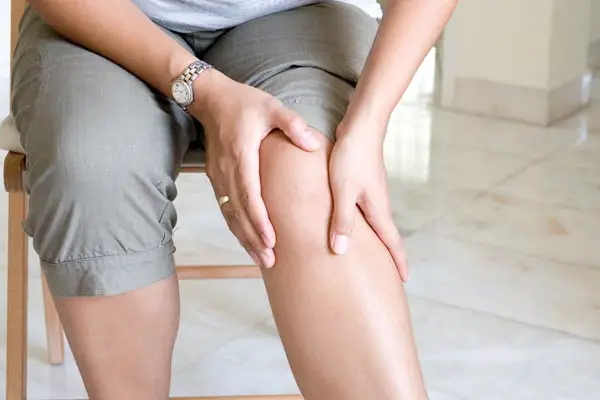Fibromyalgia is a chronic autoimmune disease that causes widespread pain in muscles and joints throughout the body.
It is also well known for causing constant, extreme fatigue. Sufferers may experience headaches and sensitivity to bright lights, loud sounds or strong scents.
A large majority of those who are diagnosed with fibromyalgia are women. Doctors aren’t exactly sure what causes the disease, but many believe that it can be brought on by mental or physical trauma.
A common complaint among sufferers of fibromyalgia is knee pain. In addition to being painful, the knee joints can be stiff and hard to move.
For those dealing with this kind of knee pain, it can be hard to get up and moving first thing in the morning or do any kind of exercise that involves walking or leg strength.
Fibromyalgia-related knee pain can be particularly bad at night (and increasingly frustrating when experienced with restless leg syndrome, another common condition for fibromyalgia sufferers). Many people report that the pain started in one knee and then progressed into both knees.
Knee pain can be particularly upsetting, as it can affect a person’s ability to move around and perform even basic daily routines and functions.
The knee and all of the surrounding leg muscles work together in a balance in order to keep everything pain-free and functioning, so one part of this system being thrown off can cause huge problems.
How to Get Relief from Knee Pain
As with any medical condition, you’ll want to make an appointment with your doctor to have your knees checked out to be sure that fibromyalgia is the cause of our pain.
Your doctor will be able to work with you to develop a good treatment program for your fibromyalgia symptoms. They will also be able to recommend which of the many treatments for knee pain may be effective in your situation.
Exercise
If there is an injury to your knee, your doctor will likely recommend rest. If there is no apparent injury and your pain is from fibromyalgia-related joint pain, the first thing your doctor is likely to suggest is exercise.
This may sound counterintuitive if your knees are hurting, but gentle movement and exercise is something that most fibromyalgia sufferers find helpful in treating their symptoms.
“Gentle” is the key word, here. When experiencing knee pain, any exercise should be low-impact. Water exercise therapy will help you get moving in a way that will take weight and pressure off of your aching knees. There are a variety of water exercise classes available.
You might do water aerobics, where you will walk, run, jump and do other cardio-type exercises that you would do on land (and in which you gradually build up cardio intensity as you get stronger). Deep-water exercise uses resistance tools such as flotation belts to give you a low-impact workout.
You can swim laps at whatever pace is comfortable for you and work on strengthening your cardio and muscles all at once.
The pool is also a great place to do yoga, tai chi, or any other sort of gentle land exercise you’d like to slow down. The water provides natural resistance to help you carefully work out your sore knees.
Massage
Although they’re excellent for relaxing and relieving stress (neither of which are bad things if you’re dealing with fibromyalgia), massage can be an excellent tool to target and attack painful muscle groups.
A knowledgeable massage therapist can focus in on muscle groups that have to do with your knee pain and work on them in order to help ease discomfort in the area.
Often, trigger points, or tiny knots in the fascia or muscle, can cause pain. Trigger points in the muscles on the thighs can cause pain that refers to the knee.
The calf can also contain trigger points that cause referred pain to the knee. A therapist who has been trained in trigger point massage will be able to locate these spots and effectively target them. While a trigger point massage can be painful and not particularly pleasant, it can provide huge relief for ongoing pain.

Acupuncture
Another strategy for relieving knee pain is acupuncture. An acupuncturist places tiny needles in various points throughout the skin.
According to traditional Chinese medicine, inserting these needles helps restore the flow of energy along its various pathways, or meridians.
Western medicine doesn’t use these terms to explain the process of acupuncture treatment, but says that it is effective.
Acupuncture helps release brain chemicals known as endorphins and enkaphalins. These can help reduce sensations of pain. It also encourages production of cortisol, which helps reduce inflammation.
Ice and Heat Treatment
One effective way of treating knee pain at home is a good, old-fashioned ice pack. Ice can help reduce pain; it can also help calm inflammation in joints and muscles.
Be careful not to leave an ice pack in place for too long (as extreme cold for long periods of time can cause damage to skin). Put the ice pack on for 10 or 20 minutes and do this as many as 3 times a day.
While ice is good for calming down painful, inflamed knees, heat may be just the thing to help ease knee stiffness before you get moving.
If you’re heading out to exercise or have a lot of walking in the day ahead, try applying heat before you leave the house.
Moist heat feels particularly good on stiff joints. You can make a homemade moist heating pad by simply taking two small towels and wetting them with water.
Wring out the excess and place one of the towels in a ziplock bag. With the bag left opened, place the ziplock in the microwave on high heat for two minutes.
Take it out (carefully—it’s hot!) and wrap the other wet towel around it. Apply it to your knee; the heat will last for approximately 20 minutes.